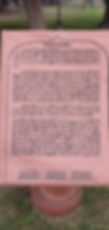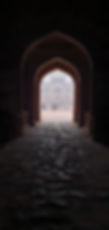These facts about Safdarjung Tomb will amaze you !!!
- Abhishek
- May 1, 2021
- 7 min read
Updated: Sep 11, 2021

Safdarjung's Tomb
Safdarjung's Tomb, situated in Delhi, is uncommon from numerous points of view. It is viewed as the last glint of wonder from the Mughals, an administration that made the absolute most amazing landmarks actually standing, including India's work of art the Taj. Other than being the last essential articulation of Mughal design, as of late a couple more reasons were added for you to visit the eighteenth-century burial place of Safdarjung.
On the off chance that you visit this landmark now, you will actually want to see the amazing landmark as well as its appearance. The Archeological Survey of India as of late resuscitated the long-outdated water channels and wellsprings around the landmark. This water body, which was important for the first arrangement, has added another measurement to the excellence of the landmark.
Moreover, Safdarjung's Tomb is one of two landmarks as of late lit up by the ASI, the other being Qutub Minar. In this way, as the sun sets the landmark is all up in lights.
When was it fabricated: 1754
Who constructed it: Nawab Shujaud Daula
Where is it situated: At the Intersection of Safdarjung Road and Aurobindo Marg, New Delhi, India
For what reason was it fabricated: Built as a tomb of Safdarjung
Compositional Style: Mughal Empire style
Visit Timing: Daily, Sunrise to Sunset
The most effective method to Reach: One can benefit taxis, auto-carts, neighborhood transports from various places of the city to arrive at the Garden Tomb; profit metro – closest station Jor Bagh; benefit directed visits orchestrated by travel services and lodgings that remember touring of the landmark for their schedule.
Overview

The Safdarjung Tomb likewise alluded to as 'Safdarjung Ka Maqbara' is a nursery burial place in New Delhi, India, made of marble and sandstone and implicit the late eighteenth century as the sepulcher of Safdarjung, a legislator who stayed the Wazir ul-Hindustan (Prime Minister of India) during the rule of Ahmad Shah Bahadur. This sepulcher worked by Safdarjung's child Nawab Shujaud Daula stays the last amazing nursery burial place portraying Mughal engineering style. Situated at the intersection of Safdarjung Road and Aurobindo Marg (Road) in New Delhi close to Safdarjung Airport, this verifiable landmark has stayed a famous place of interest pulling in both Indian and unfamiliar sightseers visiting the capital city of India.
History

Safdarjung, a Persian local and a relative of Qara Yusuf from the Kara Koyunlu, was brought into the world as Muhammad Muqim in-Khurasan in 1708 AD. In 1722 AD, he migrated to India. He turned into the Subadar Nawab of Oudh that is the leader of the territory of Oudh or Awadh area on March 19, 1739, succeeding his maternal uncle turned dad-in-law Burhan ul Mulk Saadat Ali Khan I, apparently paying off Nadir Shah with twenty million rupees. He served the situation for the duration of his life. Ruler Nasir-ud-Din Muhammad Shah presented to him the title of "Safdarjung".
Following the downfall of the Emperor, his child Ahmad Shah Bahadur rose to the seat as the new Mughal Emperor in 1748. The always incredible and clever legislator Safdarjung demonstrated his determination as a capable director moved to Delhi where he was made the Wazir ul-Mamalik-I-Hindustan or Prime Minister of Hindustan. From 1750 to 1754 he stayed the Subahdar of Assam. He was additionally made the legislative head of Ajmer. Be that as it may, because of court governmental issues, he was excused in 1753 and removed from Delhi. In December 1753 he got back to Oudh. On October 5, 1754, he died in Sultanpur close to Faizabad. The Mughal Emperor conceded the request of his child Nawab Shujaud Daula to permit the last to build a sepulcher of his dad in Delhi. The development of the burial chamber was finished in 1754.

Impression of Mughal Architectural Style

The Safdarjung Tomb, planned by an Ethiopian draftsman denotes the last gigantic nursery burial place of the Mughals. Albeit the Safdarjung Tomb was planned and developed in accordance with the popular verifiable landmark, Humayun's Tomb, the burial chamber of Mughal Emperor Humayun in Delhi, it needed both greatness and style contrasted with the last mentioned. The catacomb built on a raised stage is encircled by an immense square nursery estimating 280 meters (920 ft) on each side with a patio and a three-domed mosque housed inside the compound that is encased inside a divider.

The burial chamber that is worked of red and earthy yellow shaded sandstone has a high patio and is covered with a huge focal arch. Chunks from the sepulcher of Abdul Rahim Khankhana were utilized in its development. The two-celebrated primary passage entryway of the tomb gives a brilliant perspective on the landmark. Mind-boggling plans are made on its façade, the posterior of which houses a few rooms and a library. A deciphered rendition of an Arabic engraving scratched on its surface peruses "When the legend of plain boldness leaves from the momentary, may he become an inhabitant of god's heaven". Its square-formed focal chamber has a midway positioned cenotaph and 8 segments. Ornate mortar is utilized in the decorated inside of the sepulcher. The rubble dividers inside the burial place enhance a few discouraged curves as likewise octagonal-molded 'Chattris' or pinnacles on every one of the four corners. Dominatingly the burial place has rectangular chambers with the corner chambers being octagonal fit as a fiddle. Four polygonal pinnacles with stands are put at each edge of the primary burial place. The real graves or internment loads of Safdarjung and his significant other Amat Jahan Begum are set in an underground office of the landmark.
The huge nursery fusing the tomb, arranged as per the standard charbagh garden style of the Mughals, is disconnected into four squares with pathways and water streams around them. Each square is again apportioned into four more unassuming nurseries. One of the water streams prompts a luxuriously advanced entryway while various prompts three constructions explicitly 'Jangli Mahal' or 'Illustrious home in the forested regions, 'Badshah Pasand' or 'The Emperor's Favorite' and 'Moti Mahal' or 'Pearl Palace'.
According to genuine data, these constructions were once used as homes by the gathering of Safdarjung, at present housework environments of the 'Archeological Survey of India' (ASI). The entire burial place is before long intensely affected by the ASI which similarly keeps up the library arranged over the major entrance.

A Visit to the Garden Tomb

This fantastic nursery internment chamber arranged at the convergence of Safdarjung Road and Aurobindo Marg (Road) in New Delhi, India, stays open to visitors for the duration of the day from daybreak to nightfall. Area charges per individual for Indian inhabitants is Rs. 15/ - and for outcasts is Rs. 200/ -. The segment is free for adolescents up to 15 years of age. While still camera photography is free, Rs. 25 is charged for each camcorder.
Places To Visit Near Safdurjung Tomb
You can stop by Lodi Garden, a well-known Delhi vacation destination. Spread more than 90 sections of land, it is home to Mohammed Shah's Tomb, Tomb of Sikandar Lodi, Shisha Gumbad, and Bara Gumbad. In case you're a shopping fan, you're in for karma. Khan Market, Delhi's world-renowned hub for brand-cognizant customers, is just not far off. You can look for silver gems, gadgets, and marked garments, in addition to other things.
Interesting Facts About Safdurjung Tomb
Safdarjung Tomb draws in voyagers from around the world who are interested in the decrease of the Mughal time. Here are 4 Safdarjung burial place realities you should know about prior to visiting the design:
The engineering of the Safdarjung burial chamber is criticized for the utilization of helpless material for development.
There is an inscription in Arabic on the tomb which reads as: “When the hero of plain bravery departs from the transitory, may he become a resident of god’s paradise”.
The burial place, however underlying the style of the Taj Mahal, needs balance as the upward pivot has been given conspicuousness, which gives it a lopsided appearance.
The marble and red sandstone utilized for this construction are said to have been eliminated from the burial chamber of Abdur Rahim Khan-I-Khanan.
Tips To Travelers
Safdarjung Tomb is a declaration of the city's glory and gives a fascinating look into Delhi's superb past. Here are a couple of tips and pointers you should remember whether you intend to visit the landmark.
Paying for a nearby aide is suggested on the off chance that you look for inside and out data about the landmark.
Remember to convey a water container to keep yourself hydrated.
Trench the heels for shoes as the landscape is for the most part lopsided.
The spots to eat in the area are known to cheat sightseers, so we encourage you to convey your own bites.
Good To Know
2013 American consistent with life sensation 'Occupations' facilitated by Joshua Michael Stern and including Ashton Kutcher, Dermot Mulroney, and Josh Gad among others was recorded in the entombment place.
Conclusion

Shockingly, every single point in the complex is totally even to different focuses, and together they all mix to shape a delightful cross-section of bends, lines, flower examples, and game plans.
I caught the excellence and quietness of the spot however much I might want without the brazen guests and travelers stepping into my casing.
It's difficult enough to observe the excellence yet to notice the subtleties from assorted viewpoints, particularly when taking pictures; I took numerous photos from each conceivable spot to such an extent that cobwebs adhered to my hair and dress!
The site brags a feeling of unruffled peacefulness as it ordinarily has not many ASI staff individuals, monitors, and measurable vacationers.
Ok! Not to fail to remember the group of monkeys and gather of bright peacocks. We detected a peacock moving and remained there awestruck.
Yet, the shots at seeing peacocks are just when one visits promptly in the first part of the day as we did.
Couples discovering comfort come here to escape from individuals' snoopy and judgemental eyes (I've been seeing during my visit to better places in Delhi that segregated recorded destroys and places are sorts of Promised Land for darlings).


